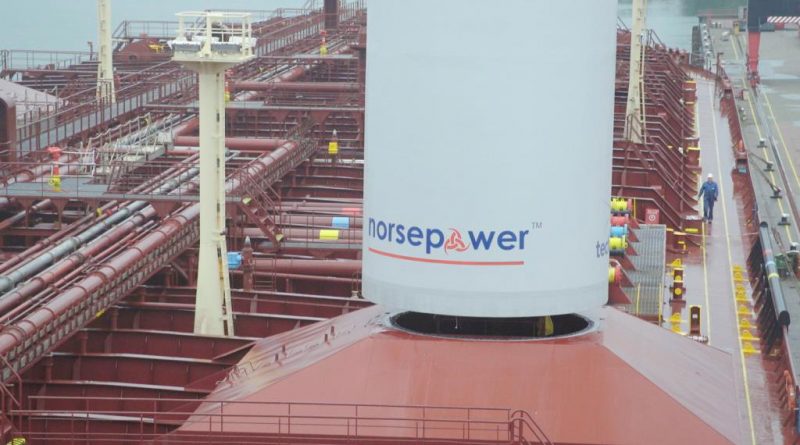Testing begins on first product tanker vessel utilising wind propulsion technology
Norsepower Oy Ltd., together with project partners Maersk Tankers, Energy Technologies Institute (ETI) and Shell Shipping & Maritime, today announced the installation of two Norsepower Rotor Sails onboard Maersk Pelican, a Maersk Tankers Long Range 2 (LR2) product tanker vessel.
The Rotor Sails are large, cylindrical mechanical sails that spin to create a pressure differential – called the Magnus effect – that propels the vessel forward. The Rotor Sails will provide auxiliary wind propulsion to the vessel, optimising fuel efficiency by reducing fuel consumption and associated emissions by an expected 7-10% on typical global shipping routes.
The Rotor Sails are the world’s largest at 30 metres tall by five metres in diameter and were installed on the product tanker vessel in the port of Rotterdam. The first voyage with the Rotor Sails installed will commence shortly.
– This project is breaking ground in the product tanker industry. While the industry has gone through decades of technological development, the use of wind propulsion technology onboard a product tanker vessel could take us to a new playing field. This new technology has the potential to help the industry be more cost-competitive as it moves cargoes around the world for customers and to reduce the environmental impact – said Tommy Thomassen, Chief Technical Officer, Maersk Tankers.
The Rotor Sails have completed rigorous land testing, including thorough testing of various mechanical and performance criteria, and is the first Rotor Sails to be Class approved for use on a product tanker vessel. Extensive measurement and evaluation of the effectiveness of the Rotor Sails will now take place to test the long-term financial and technical viability of the technology. Independent experts from Lloyd’s Register’s (LR’s) Ship Performance team will acquire and analyse the performance data during the test phase to ensure an impartial assessment before technical and operational insights as well as performance studies are published.
Andrew Scott, Programme Manager HDV marine and offshore renewable energy, ETI explained:
– We commissioned this project to provide a unique opportunity to demonstrate the untapped potential of Rotor Sails. Auxiliary wind propulsion is one of the few fuel-saving technologies that is expected to offer double-digit percentage improvements. The technology is projected to be particularly suitable for tankers and dry bulk carriers, and this test will assist in determining the further potential for Rotor Sails in the product tanker industry.
Tuomas Riski, CEO, Norsepower, added:
– We have great ambitions for our technology and its role in decarbonising the shipping industry. The installation of our largest ever Rotor Sails in partnership with these industry leading organisations shows that there is an appetite to apply new technologies.
– With this installation on the Maersk Pelican, there are now three vessels in daily commercial operation using Norsepower’s Rotor Sails. Each of these cases represents a very different vessel type and operational profile, demonstrating the widespread opportunity to harness the wind through Flettner rotors across the maritime industry.
Dr. Grahaeme Henderson, Vice-President, Shell Shipping & Maritime, concluded:
– The shipping industry faces a major challenge in how it can economically ship the increasing amounts of goods and energy the world demands, whilst lowering its environmental impact. We see significant advantages in embracing, testing and driving innovative technologies that we believe show real promise in helping the shipping industry meet this challenge.
Norsepower’s Rotor Sail solution is the first data-verified and commercially operational auxiliary wind propulsion technology available for the global maritime industry. When wind conditions are favourable the main engines can be throttled back, saving fuel and reducing emissions, while maintaining speed and voyage time. Each Norsepower Rotor Sail is made using lightweight composite sandwich materials, which ensure the Rotor Sail remains well-balanced and offers a hi-tech, low maintenance solution.
Foto: Maersk Tankers


